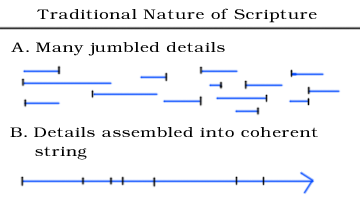The Nature of Scripture 1
Most Evangelicals or Protestants look at scripture as a mass of small, disconnected details that must be arranged and placed together into a straight line so that it forms a working and coherent system. Thus, a detail can have dramatic consequences on the whole because importance is placed on each detail in order to align them together into a complete line or unified string. See the following graphical representation:
 This is where grammatical meanings of words and phrases become of vital importance. Great time is spent dissecting bits of script to come to a pure understanding of the construction since what is most important are the individual pieces or details (which also leads to a focus on literal meaning and plain sense interpretation).
This is where grammatical meanings of words and phrases become of vital importance. Great time is spent dissecting bits of script to come to a pure understanding of the construction since what is most important are the individual pieces or details (which also leads to a focus on literal meaning and plain sense interpretation).
Harmonization, whereby less clear and seemingly conflicting texts are understood in light of ones that are supposedly clear as day, is also a key player in approaching scripture in this model. Why? Because the unified whole depends on each detail fitting together. If a detail doesn't fit, then this calls into question the overall structure and meaning—i.e. an individual detail can destroy the whole string like one weak link in a chain.
Thus, for instance, it becomes a major issue whether or not there is an article in John 1:1 because something as seemingly insignificant as a few letters can destroy an entire theology since details must support one another in order to form a complete string. This is why proof-texting--reference to a single or dozen individual, de-contexualized verses—is so important. Back it up with scripture, the Evangelical or Protestant will say, by which they mean, following this model, show me how all these details make sense together. And they will probably point to one or a dozen different details that conflict with your theological string and therefore can have tyrannical vetoing power over the whole.
(to be continued)
 This is where grammatical meanings of words and phrases become of vital importance. Great time is spent dissecting bits of script to come to a pure understanding of the construction since what is most important are the individual pieces or details (which also leads to a focus on literal meaning and plain sense interpretation).
This is where grammatical meanings of words and phrases become of vital importance. Great time is spent dissecting bits of script to come to a pure understanding of the construction since what is most important are the individual pieces or details (which also leads to a focus on literal meaning and plain sense interpretation).Harmonization, whereby less clear and seemingly conflicting texts are understood in light of ones that are supposedly clear as day, is also a key player in approaching scripture in this model. Why? Because the unified whole depends on each detail fitting together. If a detail doesn't fit, then this calls into question the overall structure and meaning—i.e. an individual detail can destroy the whole string like one weak link in a chain.
Thus, for instance, it becomes a major issue whether or not there is an article in John 1:1 because something as seemingly insignificant as a few letters can destroy an entire theology since details must support one another in order to form a complete string. This is why proof-texting--reference to a single or dozen individual, de-contexualized verses—is so important. Back it up with scripture, the Evangelical or Protestant will say, by which they mean, following this model, show me how all these details make sense together. And they will probably point to one or a dozen different details that conflict with your theological string and therefore can have tyrannical vetoing power over the whole.
(to be continued)

0 Comments:
Post a Comment
<< Home